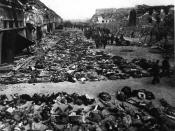Chen � PAGE \* MERGEFORMAT �1�
English 45C
Objective Haunting
After thirteen years of dedicated research and constant redrafting, Art Spiegelman created his two- volume masterpiece: Maus. As the child of a Holocaust survivor, Spiegelman1 sought to embody the Jewish experience in graphic novel form. Little did he know, the information he dug up would haunt him forever. Spiegelman subsequently incorporated the story of his research process with his father's tale of survival, adding a mixture of objects to symbolize the past's effect on the present. Throughout Maus, Spiegelman uses objects - even those which are physically destroyed - to signify the permanence of a traumatic past that permeates into the present through physical and emotional haunting, depicted by Vladek's deteriorating body and psyche as well as Artie's involuntary transgenerational inheritance of the Holocaust experience.
Medicine conveys the idea that physical haunting from past suffering continues into the present as the Holocaust has evidently taken a toll on Vladek's body.
From the beginning, Vladek shows signs of deteriorating health. He counts out over 30 pills for his daily needs, mentioning heart problems, vitamin deficiencies, and diabetes. (Spiegelman I.26). At first, this dependence on medicine could be dismissed as effects of old age, but the pills reappear later to affirm the idea that Vladek's health stems from past trauma. In two different instances, Vladek spills his medicine when talking about the past. He first knocks over his pills after making a "Heil Hitler" motion while talking about Artie's deformed arm as a baby. (I.30). By spilling his pills, Vladek's physical health is temporarily threatened since he is hindered from treating his current illnesses. The fact that he's talking about Hitler - the perpetrator of Jewish extermination policies - when he knocks over the pills creates a link with the...


